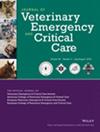Distribution of equine and food animal emergency caseload by time of day, day of week, time of year, holiday, and phase of moon at an academic ambulatory and referral hospital
Abstract
Objective
Determine the association of time of day, day of week, time of year, holiday, and phase of moon on academic ambulatory and hospital emergency caseload for equine and food animal species.
Design
Retrospective study.
Setting
Large animal teaching hospital emergency service.
Animals
Equine and food animals.
Interventions
None.
Measurements and Main Results
The hospital database was searched for after-hours on-farm and in-hospital emergencies seen from 2014 to 2020. Variables included date and time of admission, species (equine or food/fiber animal [FA]), and hospital service (field or in-hospital). The association of the caseload with time of day, day of week, day of year (holiday, full moon, or new moon), and season of year was defined and examined. The majority of equine field-based emergencies occurred on the weekend, in contrast to 44.8% of hospital cases. Most equine emergencies occurred between 4:00 p.m. and midnight on weekdays and between 8:00 a.m. and 4:00 p.m. on weekends for both field (89.1% and 46.9%) and hospital (82.8% and 48%) services. The same was true for FA cases on the farm (90% and 49.2%) and in the hospital (85% and 51.4%). More equine cases (67%) were seen in the field than FA. Winter had the fewest emergency cases for all species and locations, and spring had the most for FA. The majority of holiday equine emergencies were seen in the field (62.2%), but the majority of holiday FA emergencies were seen in the hospital (66.3%). Moon phase had no significance on caseload for all species and locations.
Conclusions
Saturdays and Sundays were the busiest days for all species and services. Winter was the slowest time for emergencies for all species and services. Most emergencies were seen between 4:00 p.m. and midnight on weekdays and between 8:00 a.m. and 4:00 p.m. on Sundays and Saturdays.

 求助内容:
求助内容: 应助结果提醒方式:
应助结果提醒方式:


